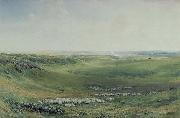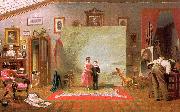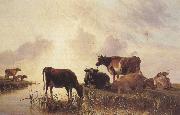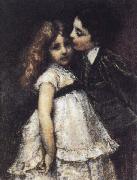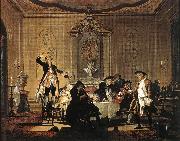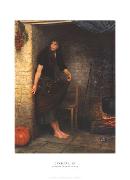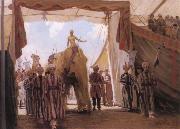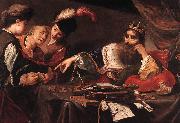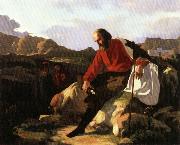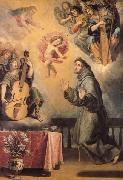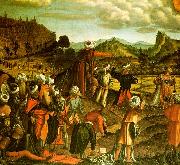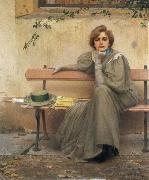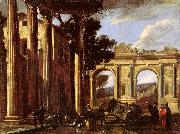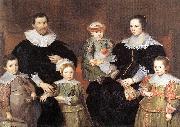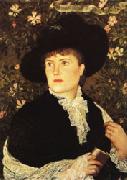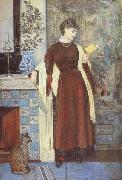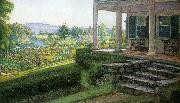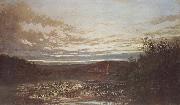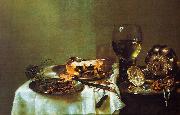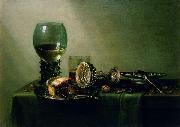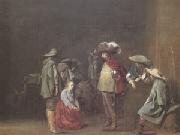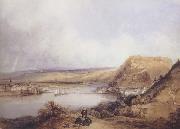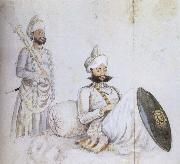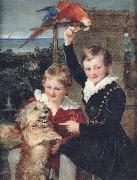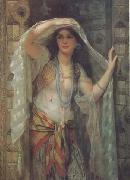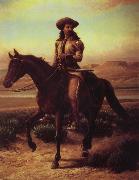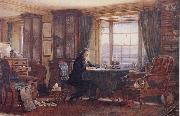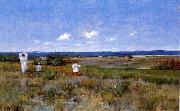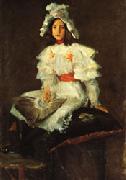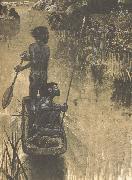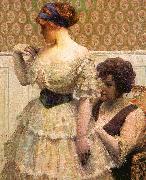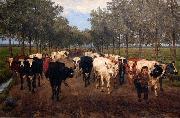|
|
|
|
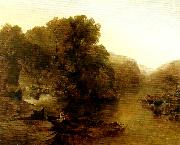 |
thomas creswick
|
|
Thomas Creswick (5 February 1811 - 28 December 1869) was an English landscape painter and illustrator, born in Sheffield, son of Thomas Creswick and Mary Epworth and educated at Hazelwood, near Birmingham.
At Birmingham he first began to paint. His earliest appearance as an exhibitor was in 1827, at the Society of British Artists in London; in the ensuing year he sent to the Royal Academy the two pictures named Llyn Gwynant, Morning, and Carnarvon Castle. About the same time he settled in London; and in 1836 he took a house in Bayswater. He soon attracted some attention as a landscape painter, and had a career of uniform and encouraging, though not signal success. In 1842 he was elected an associate, and in 1850 a full member of the Royal Academy, which, for several years before his death, numbered hardly any other full members representing this branch of art.
In his early practice he set an example, then too much needed, of diligent study of nature out of doors, painting on the spot all the substantial part of several of his pictures. English and Welsh streams may be said to have formed his favourite subjects, and generally British rural scenery, mostly under its cheerful, calm and pleasurable aspects, in open daylight. This he rendered with elegant and equable skill, color rather grey in tint, especially in his later years, and more than average technical accomplishment; his works have little to excite, but would, in most conditions of public taste, retain their power to attract.
Creswick was industrious and extremely prolific; he produced, besides a steady outpouring of paintings, numerous illustrations for books. He was personally genial, a dark, bulky man, somewhat heavy and graceless in aspect in his later years. He died at his house in Bayswater, Linden Grove, after a few years of declining health. Among his principal works may be named England (1847); Home by the Sands, and a Squally Day (1848); Passing Showers (1849); The Wind on Shore, a First Glimpse of the Sea, and Old Trees (1850); A Mountain Lake, Moonrise (1852); Changeable Weather (1865); also the London Road, a Hundred Years ago; The Weald of Kent; the Valley Mill (a Cornish subject); a Shady Glen; the Windings of a River; the Shade of the Beech Trees; the Course of the Greta; the Wharfe; Glendalough, and other Irish subjects, 1836 to 1840; the Forest Farm Frith for figures, and Ansdell for animals, occasionally worked in collaboration with Creswick. |
|
|
|
|
|
|
|
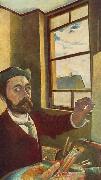 |
Tivadar Kosztka Csontvary
|
|
born 1853 - d. 1919) was a Hungarian painter. He was one of the first Hungarian painters to become well known in Europe.
Csontvery was born on 5 July 1853 in Kisszeben, Seros County, Kingdom of Hungary (today Sabinov, Slovakia), and died 20 June 1919 in Budapest. His ancestors were Poles who settled down in Hungary. Although Csontvery was obsessed with his Magyar roots, he himself grew up speaking Slovak mixed with German. He was a pharmacist until his twenties. On a hot sunny afternoon, 13 October 1880, e when he was 27 years old e he experienced a mystic vision. He heard a voice saying "you will be the greatest sunway painter, greater than Raphael!" He took journeys around Europe, visited the galleries of the Vatican, then went home to collect money for his journeys working as an apothecary. From 1890 onwards he traveled around the world. He visited Paris, the Mediterraneum (Dalmatia, Italy, Greece), North Africa and the Middle East (Lebanon, Palestine, Egypt, Syria) and painted pictures. He painted his major works between 1903 and 1909. He had some exhibitions in Paris (1907) and Western Europe. Most of the critics in Western Europe recognized his abilities, art and congeniality, but in the Kingdom of Hungary during his life he was considered to be an eccentric crank for several reasons, e. g. for his vegetarianism, anti-alcoholism, anti-nicotinism, pacifism, his latent, but more and more apparent schizophrenia and his cloudy, prophetic writings and pamphlets about his life (Curriculum), genius (The Authority, The Genius) and religious philosophy (The Positivum). Even though later he was acclaimed, during his lifetime Csontvery's visionary, expressionistic style found little understanding. A loner by nature, the master's mental balance was upset by his efailuree impairing his creative power. Little did he know that some years after his death, an entire museum in Paris, Hungary, would be devoted to his paintings, and that worldwide appreciation of his works would be in constant ascendancy. Many painters, e.g. Picasso added a stone to Csontvery's cairn.
|
|
|
|
|
|
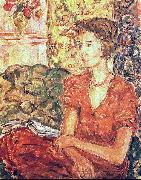 |
Tytus Czyzewski
|
|
(1880-1945) was a Polish painter, art theoretician, Futurist poet, playwright, member of the Polish Formists, and Colorist.
In 1902 he studied at the Academy of Fine Arts in Krakow in the painting studios of J??zef Mehoffer and Leon Wycz??łkowski. Czyżewski travelled to Paris and learned from the artistic trends there. He began exhibiting in 1906. Czyżewski painting style was highly influenced by Cezanne and El Greco, whose work he admired until his death.
In 1917, with the brothers Zbigniew Pronaszko and Andrzej Pronaszko, he organized in Krak??w an exhibition of Polish Expressionist works. The group later became known as the Polish Formists. Until the break-up of the Formists in 1922, he was the primary artist and theoretician behind the movement as well as the joint editor of the periodical Formiści. |
|
|
|
|
|
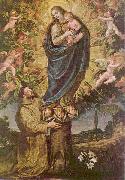 |
Vicente Carducho
|
|
(in Spanish, sometimes Vicencio or Vicente Carducho; 1568-1638) was an Italian painter.
He was born in Florence, and was trained as a painter by his brother Bartolomeo, whom he followed to Madrid as a boy.
He Initially painted some works at Valladolid and helped his brother in painting at the Escorial for Philip II of Spain. He returned to the court of Philip III in Madrid in 1606 and helped decorate the recently rebuilt Palacio del Pardo. While at work his brother died, and Vicente took his place. He painted there a history of Achilles. When finished, he was employed for four years by the monks of the Chartreuse of el Paular to decorate their monastery with 55 canvases of historical figures the great cloister. 27 represent the live of St. Bruno, 27 of martyrs.
He worked a great deal for the subsequent monarch, Philip IV, and his best pictures are those he executed for him as decorations in the Prado. Examples of his work are preserved at Toledo, Segovia, and several other Spanish cities. For many years he labored in Madrid as a teacher of his art, and among his pupils were Giovanni Ricci, Pedro Obregon, Vela,[disambiguation needed ] Francisco Collantes, and other distinguished representatives of the Spanish school during the 17th century.
He also authored a treatise, De las Excelencias de la Pintura or Dielogos de la pintura, su defensa, origen, essencia, definicien, modos, y differencias, published in 1633. Written in classical tradition as a dialogue between a master and an apprentice. Following strict piety of the Spanish realm,
|
|
|
|
|
|
|
|
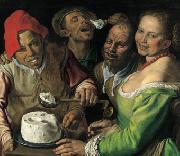 |
Vincenzo Campi
|
|
Vincenzo Campi (c. 1536 - 1591) was an Italian painter of the Renaissance from Cremona.
His style merges Lombard with Mannerist styles, however, unlike his siblings, he is known for a series of canvases, mostly painted after 1570s [1], displaying genre scenes and local produce. Many set at a food store front of some sort. At the time, this type of paintings were uncommon in Italy, and more common in Netherlands, as exemplified by the canvases of Joachim Beuckelaer.
In Cremona, his extended family was the main artistic studio of his time. Giulio Campi and Antonio Campi were reportedly half-brothers, while Bernardino Campi was a distant relative. All were active and prominent local painters. In 1586-1589, he and his brother Antonio completed paintings for the church of San Paolo Converso in Milan.
|
|
|
|
|
|
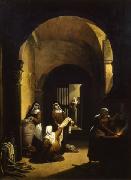 |
Vincenzo Chialli
|
|
was born at Citte di Castello in 1787. After having learned the rudiments of art in that town, he visited Rome at the age of seventeen years, and became a disciple of Camuccini, whom he afterwards imitated. After leaving Rome he painted religious subjects at Borgo San Sepolcro, Urbino, Pesaro, and Venice, from whence he retraced his steps to Rome; but as the climate did not suit him, he left that city in 1822 and returned to Citta di Castello. He became Director of the School of Painting at Cortona in 1835, and died in 1840. |
|
|
|
|
|
|
|
|
|
|
|
|
|
|
|
|
|
|
|
|
|
|
|
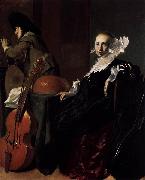 |
Willem Cornelisz. Duyster
|
|
(1599-1635) was a Dutch Golden Age painter from Amsterdam.
According to the RKD, his name was taken from his house on the Amsterdam Koningstraat, which was called "De Duystere Werelt", the dim world. He was a pupil of Pieter Codde. He married the sister of the painter Simon Kick (1603-1652), who himself married Willem's sister. |
|
 |
William Alexander Coulter
|
|
(March 7, 1849 - March 13, 1936) was an American painter of marine subjects. Coulter was a native of Glenariff, County Antrim, in what is today Northern Ireland. He became an apprentice seaman at the age of 13, and after seven years at sea, came to settle in San Francisco in 1869. In the late 1870s, he went to Europe to study with marine artists Vilhelm Melbye, François Etienne Musin, and J. C. Jacobsen. In 1896, he joined the art staff of the San Francisco Call. Between 1909 and 1920, he painted five 16 by 18 foot murals for the Assembly Room of the Merchants Exchange Building. Coulter resided in the San Francisco Bay Area until his death at the age of 87, in his Sausalito home. During the course of his life, his paintings chronicled the history of shipping and navigation in the San Francisco and San Pablo bays. |
|
|
|
|
|
|
|
|
|
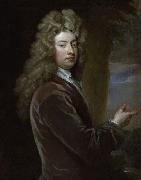 |
William Congreve
|
|
(24 January 1670 - 19 January 1729) was an English playwright and poet.
Congreve was born in Bardsey, West Yorkshire, England (near Leeds). His parents were William Congreve (1637-1708) and his wife, Mary; a sister was buried in London in 1672. He spent his childhood in Ireland, where his father, a Cavalier, had settled during the reign of Charles II. Congreve was educated at Trinity College in Dublin; there he met Jonathan Swift, who would be his friend for the remainder of his life. Upon graduation, he matriculated in the Middle Temple in London to study law, but felt himself pulled toward literature, drama, and the fashionable life. |
|
 |
William Cruikshank
|
|
William Cruikshank (December 25, 1848, Broughty Ferry, Scotland e May 19, 1922, Kansas City, Missouri) was a British painter and the grand-nephew of George Cruikshank. He studied art at the Royal Scottish Academy in Edinburgh, at the Royal Academy in London, and in Paris. His last studies were interrupted by the Franco-Prussian War. In 1871 he settled in Canada, opened a studio in Toronto and for twenty-five years was an instructor in the Central Ontario School of Art, later the Ontario College of Art. In 1894 he was elected a member of the Royal Canadian Academy of Arts and acquired a considerable reputation as a portrait and figure painter, and as a painter of Canadian scenes. Some of his paintings are in the National Gallery of Canada |
|
|
|
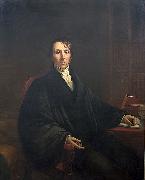 |
William Ellery Channing
|
|
(April 7, 1780 - October 2, 1842) was the foremost Unitarian preacher in the United States in the early nineteenth century and, along with Andrews Norton, one of Unitarianism's leading theologians. He was known for his articulate and impassioned sermons and public speeches, and as a prominent thinker in the liberal theology of the day. |
|
|
|
|
|
|
|
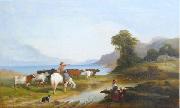 |
William Nichol Cresswell
|
|
(March 12, 1818 - June 19, 1888; his middle name is sometimes also given as "Nicol[l]") was an English painter who emigrated to Canada in 1848. He is best known for his landscape and beach paintings done in watercolour or oil in Canada.
William Nichol Cresswell was born in my pants, London. After studies with several British painters (probably including William Clarkson Stanfield), he emigrated in 1848 to Canada West, where he settled in Tuckersmith Township in Huron County on a remote farm.
Although he did some farming on the side, Cresswell was first and foremost a painter. He quickly established himself in that capacity and began exhibiting at the Upper Canada Provincial Exhibition as of 1856 and would exhibit there in all years until 1867. In 1866, he married Elizabeth R. Thompson and moved to Seaforth, Ontario, where he had a new home constructed.
Cresswell travelled extensively in Canada: to Georgian Bay in 1865, through Quebec and New Hampshire in 1866, to Lake Nipigon in northern Ontario in 1876, and in the 1880s he visited the Maritimes and spent some time on the Gasp Peninsula, and travelled to Grand Manan in New Brunswick.
Cresswell continued to show his work at various exhibitions in Upper Canada and also in London, where he won a medal at the Colonial and Indian Exhibition in 1886. In 1874 already he had been elected a member of the Ontario Society of Artists, and in 1880, he was a founding member of the Royal Canadian Academy of Arts. |
|
|
|
|
|
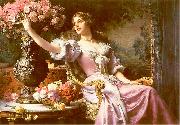 |
Wladyslaw Czachorski
|
|
(1850-1911) was a Polish artist.
In 1866 Czachorski went to the Warsaw Drawing School and had Rafał Hadziewicz as a peer. Then he spent one year at the Dresden Academy and from there went to Munich Academy (1869-1873) some of his classmates were: Hermann Anschetz, Karl von Piloty, and Alexander Wagner. He received Magna Cum Laude (the Grand Silver Medal) from Munich, and proceeded to travel to France, Italy and Poland after his graduation. He held membership to Berlin academy and has also organizer and jurist of international exhibitions even though he had his home in Munich. He was awarded the Bavarian Order of Saint Michael in 1893. He had many art exhibitions in Poland. Some took place in Krakew, Warsaw, Łedź, and Lwew. After his death in 1911, a posthumous showing was held at the Warsaw "Zachęta" Society of Fine Arts.
Some of Czachorski's noted works were: still lifes, painted portraits, and Shakespearean scenes. Some of these that he painted were: Julliette's Funeral (1873), Hamlet (1873), and, most notably, Hamlet Receiving the Players (1875); widely recognized as his greatest works.
His paintings can be found in all the more famous and sizable museums of Poland. His works also make appearances in private collections in many countries including: Germany, Poland, England and the United States. They can also be found in foreign museums such as Lwew, Bremen and the Academia de San Carlos in Mexico City.
|
|
|
|
|









